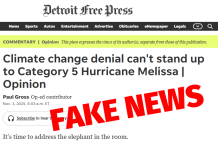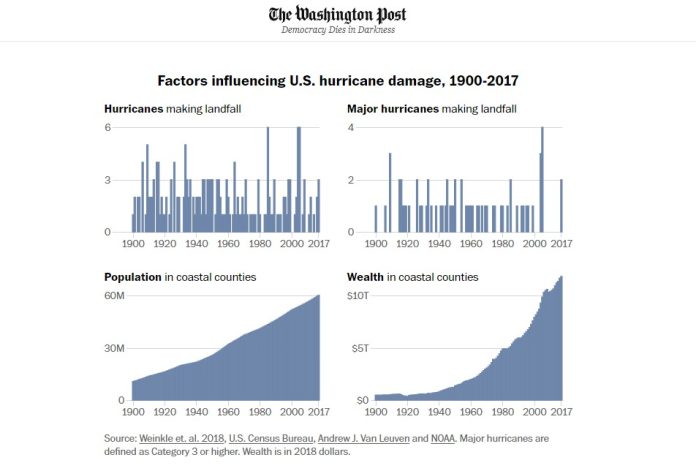The Washington Post (WaPo) recently published an article titled “The real reason billion-dollar disasters like Hurricane Helene are growing more common,” which accurately explained that billion dollar disasters are not getting more common because the storms are getting more extreme or common, but rather that economic and population trends have changed. This is true. Despite the article asserting at its outset that climate change is a problem and that we shouldn’t question a transition away from fossil fuels, it provides, on the whole, a fairly balanced and accurate discussion of why natural disaster costs are rising.
WaPo writes:
The billion-dollar disaster dataset is “quoted a lot and people use it as a way of saying that climate change is already influencing what we see. And yet, unless you get the economics right, you can’t really justify that,” said D. James Baker, the physicist and oceanographer who led NOAA from 1993 to 2001, the longest tenure as administrator in the agency’s history.
Baker and others say disputing whether global warming’s influence can be found in the disaster data is not the same as questioning whether climate change is real or whether society should switch from fossil fuels.
“We know that climate change is real. We don’t see it in the [economic] losses yet,” said Laurens Bouwer, an expert on the assessment of climate risks and a lead author on five reports by the U.N. Intergovernmental Panel on Climate Change, the advisory body through which scientists reach consensus on climate change.
This is true, more or less (minus the part about getting rid of fossil fuels), with WaPo’s article going into great detail about how the “billion-dollar disasters” narrative gets off track.
Climate Realism has touched on this a number of times (here, here, and here, to name a few). Basically the claim goes something like this: the costs of weather disasters are increasing because weather is getting worse due to human-caused climate change. Weather data demonstrates that this claim is patently false. Almost universally, data show that storms like hurricanes and tornadoes are not becoming more frequent or extreme. Nor are instances of flooding or periods of drought.
So what’s the explanation for increasing billion-dollar disasters?
Roger Pielke Jr., a scientist from the National Center for Atmospheric Research, has long studied the costs implications of natural disasters, putting them in context. WaPo reached out to him for the article because his research in the 1990s found that hurricane damage has not grown at all when you account for population and property value changes in hurricane-prone regions. He has frequently railed against this misuse of data, calling the National Climate Assessment (NCA) report’s use of the claim a “national embarrassment.” Even worse than trying to merely claim the number of billion dollar disasters are increasing due to climate change, the NCA overestimated the real number of disasters by a factor of three by double and triple counting individual events when they hit more than one state, regardless of whether or not the event produced a billion dollars of damage in each affected state.
On his own Substack, Pielke points out that the WaPo article managed to get some “remarkable” comments from various supposed climate experts, where they admit that they are operating on assumptions of attribution, or make the disaster-costs to climate connection because there is “pressure” and not necessarily because the science backs it up.
In the end, WaPo gets disaster cost attribution right, writing:
[A]ccording to disaster experts, former NOAA officials, and peer-reviewed scientific studies . . . [t]he truth [is] … over time, migration to hazard-prone areas has increased, putting more people and property in harm’s way. Disasters are more expensive because there is more to destroy.
. . .
Each year brought a longer list of disasters, but … meteorologists Neal Lott and Tom Ross [of] the National Climatic Data Center … did not think the weather had changed. Instead, they noticed there were more people and property in areas prone to natural hazards.
It’s nice when WaPo, normally one of the worst offenders when it comes to climate-related fake news and misinformation, finally gets a story right. Climate change is not causing worsening weather and so can’t be responsible for rising weather-related costs. One can only hope other media outlets begin to follow WaPo’s example, in this instance, and publish balanced, fact-based, informative pieces on climate change, leaving out WaPo’s editorializing on the need to get rid of fossil fuels, which would, of course, prove disastrous in terms of storm preparedness, human avoidance, resilience, and recovery.
























The GHE is overstated by 100 to 1. That’s right: GHGs only re-radiate 1% of the thermal energy they absorb because they are the energy source of warming the 99% non-GHGs at each altitude. This is called Local Thermal Equilibrium and it’s textbook thermodynamics. Well if the 1% GHGs have to bring the 99% non-GHGs at each altitude to equal thermal energy (which can only happen via collisions, or conduction) that leaves only 1% to radiate. Q.E.D.